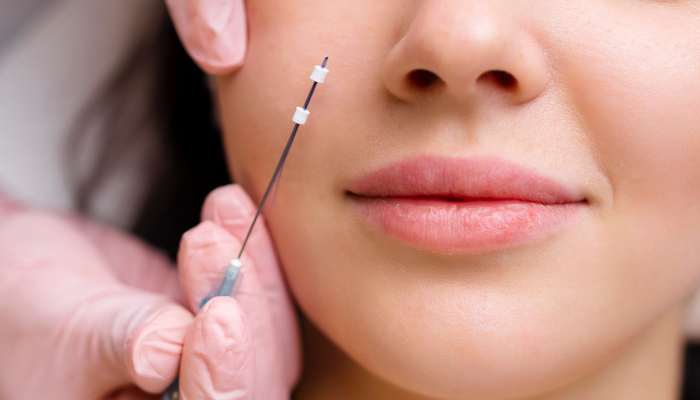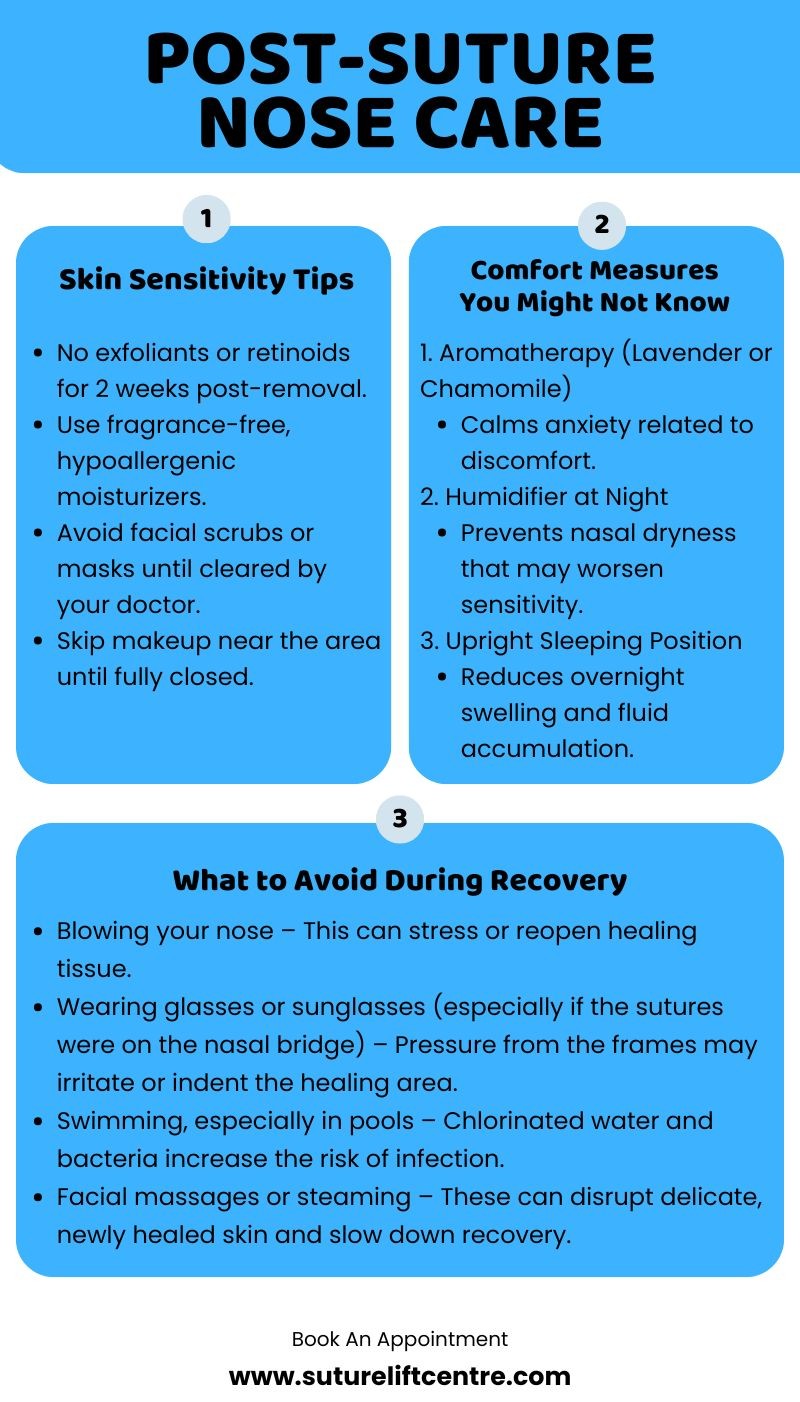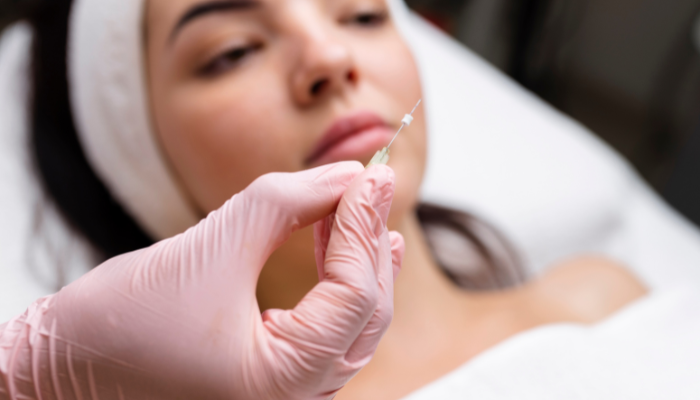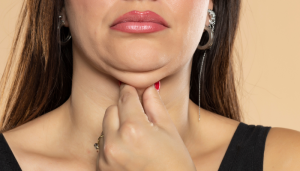Getting stitches out of your nose might sound a little intimidating—but don’t worry, it’s a routine step on your road to recovery. You’re probably curious—maybe even a little nervous—about what it’ll feel like and how to care for your nose afterward.
The good news? Suture removal is usually quick, simple, and nothing to stress over. In this guide, you’ll learn exactly what to expect and get easy aftercare tips to keep your healing on track. Let’s take the guesswork out of the process and make recovery smooth and stress-free.
Key Takeaways
- Nose suture removal is a straightforward procedure that requires minimal downtime.
- It’s essential to maintain cleanliness in the area to prevent infections post-removal.
- You may experience some discomfort, but there are effective pain management techniques available.
- Avoid strenuous activities for a few days after the procedure to aid healing.
- If you notice any unusual symptoms, don’t hesitate to contact your healthcare provider.
Understanding The Nose Suture Removal Process

What Is Nose Suture Removal?
Nose suture removal is, quite simply, the process of taking out the stitches that were used to close an incision after a nose-related surgery or injury. These sutures, or stitches, hold the skin together to promote healing.
Think of it as the final step in your recovery journey, allowing your skin to fully knit together.
Why Is It Necessary?
Sutures are essential for proper wound closure, but they aren’t meant to stay in forever. Here’s why removal is important:
- To prevent infection: Sutures can become a breeding ground for bacteria if left in too long.
- To avoid skin irritation: Prolonged presence can cause redness, itching, and general discomfort.
- To allow normal skin function: Sutures can restrict movement and sensation in the area.
Leaving sutures in place indefinitely can lead to complications like suture granulomas (small, inflamed nodules) or even scarring. It’s all about timing – removing them at the right moment ensures the best possible outcome for your healing nose.
How Is The Procedure Performed?
The removal itself is usually quick and straightforward. A healthcare professional will use sterile instruments to carefully snip and pull out each suture. Here’s a general idea of what to expect:
- The area will be cleaned with an antiseptic solution.
- The healthcare provider will use tweezers to gently lift the suture.
- Small scissors or a scalpel will be used to cut the suture close to the skin.
- The suture will be gently pulled out.
- The area will be cleaned again, and possibly covered with a small bandage if needed.
It’s generally a painless procedure, though you might feel a slight tugging or pulling sensation. If you’re anxious, let your practitioner know – they can talk you through it and make sure you’re comfortable.
What To Expect During The Appointment
Preparation Steps
Before you head in for your appointment, there are a few things you can do to make the process smoother.
- Make sure you’ve had a good night’s sleep – being well-rested can help with any minor discomfort.
- Avoid wearing makeup or heavy creams on your nose the day of the removal, as this can interfere with the sterilisation process.
- It’s also a good idea to eat a light meal beforehand to prevent feeling lightheaded.
Finally, bring a list of any questions you have for the practitioner; it’s always good to be informed!
What Happens During Removal?
So, what actually happens when you get there? Well, first off, the practitioner will clean the area around your nose to minimise the risk of infection. They’ll then use sterile instruments, usually small forceps or scissors, to gently lift and snip the sutures.
The process is generally quick, and most people report feeling minimal discomfort. The practitioner will carefully inspect the area after each suture is removed to ensure nothing is left behind. It’s all very precise and methodical.
Post-Removal Observations
After the sutures are out, the practitioner will likely apply a topical antibiotic ointment to help prevent infection. They’ll also give you specific aftercare instructions, which are super important to follow. You might notice some slight redness or minor swelling immediately after, but this usually subsides within a few hours.
It’s a good idea to avoid touching your nose unnecessarily and to keep the area clean. If you have any concerns or notice anything unusual, don’t hesitate to contact the clinic.
It’s normal to feel a bit anxious before the appointment, but remember that suture removal is a routine procedure. The practitioner is there to guide you through it and ensure you’re comfortable every step of the way. Just relax, follow their instructions, and you’ll be fine.
Managing Discomfort After Removal

Sutures are out! Now, let’s talk about how to handle any discomfort you might be feeling. It’s totally normal to experience a few things, but don’t worry, we’ll get you through it.
Common Sensations
So what’s normal? You might feel a bit of tenderness or a slight pulling sensation where the sutures were. Some people describe it as a mild ache. It’s also possible to have some itching as the skin starts to heal.
These sensations are usually pretty mild and fade away within a few days. If anything feels really intense or out of the ordinary, though, definitely give your practitioner a shout.
Pain Management Techniques
For most people, over-the-counter pain relief is more than enough. Paracetamol or ibuprofen can help take the edge off any discomfort. A cold compress applied gently to the area can also work wonders for reducing swelling and numbing any pain.
Just make sure you wrap the compress in a clean cloth to protect your skin.
Here’s a quick rundown:
- Over-the-counter pain relievers: Follow the instructions on the packet.
- Cold compress: Apply for 15-20 minutes at a time, several times a day.
- Gentle touch: Avoid rubbing or putting pressure on the area.
Remember, everyone’s pain threshold is different. What works for one person might not work for another. The key is to listen to your body and find what brings you the most comfort.
When To Seek Help
While some discomfort is expected, there are definitely times when you should seek professional help.
Keep an eye out for these signs:
- Increased pain: If the pain gets worse instead of better, it’s a red flag.
- Signs of infection: Redness, swelling, pus, or a fever could indicate an infection.
- Excessive bleeding: A little bit of spotting is normal, but heavy bleeding isn’t.
If you experience any of these, don’t hesitate to contact your practitioner. It’s always better to be safe than sorry!
Essential Aftercare Guidelines
Keeping The Area Clean
Keeping the area clean is absolutely key to preventing infection and promoting proper healing. Avoid scrubbing or using harsh chemicals, as this can irritate the skin. Pat the area dry with a clean, soft towel – don’t rub!
Do this twice a day, morning and night, or as directed by your practitioner. It’s a simple step, but it makes a massive difference.
Avoiding Certain Activities
Okay, so you’re probably feeling pretty good after getting those sutures out, but it’s not time to go wild just yet. For the first few days, try to avoid activities that could put stress on the area.
That means no heavy lifting, strenuous exercise, or anything that might cause you to bump or rub your nose. I know it’s a pain, but it’s better to be safe than sorry. Also, try to avoid excessive sun exposure. If you must be outside, wear a hat and apply a gentle, fragrance-free sunscreen to the area.
Signs Of Complications
Look, most of the time, suture removal goes off without a hitch. But it’s always good to know what to watch out for, just in case. Keep an eye out for signs of infection, like increased redness, swelling, pain, or pus.
If you notice any of these, or if you develop a fever, get in touch with your practitioner straight away. Don’t try to diagnose or treat it yourself – it’s always best to get a professional opinion. Also, if the wound starts to open up, or if you experience any unusual bleeding, seek medical attention immediately.
After suture removal, it’s normal to experience some mild discomfort or slight bruising. However, if you notice any signs of infection or complications, it’s important to seek medical attention promptly. Early intervention can help prevent further issues and ensure a smooth recovery process.
Long-Term Care For Optimal Results
Maintaining Skin Health
Once your nose suture removal is complete, it’s important to focus on maintaining the health of your skin. This involves a few key steps.
- Firstly, gentle cleansing is paramount. Use a mild, fragrance-free cleanser to avoid irritating the area.
- Secondly, moisturise regularly to keep the skin hydrated and promote healing.
- Finally, always apply a broad-spectrum sunscreen, even on cloudy days, to protect the delicate skin from sun damage.
This will help prevent hyperpigmentation and ensure the best possible long-term outcome.
Follow-Up Appointments
Don’t skip your follow-up appointments! These are scheduled for a reason. They allow your practitioner to monitor your healing progress and address any concerns you might have.
These appointments are a great opportunity to ask questions and ensure everything is on track. Think of them as a safety net, ensuring you achieve the best possible results from your suture removal.
Lifestyle Tips For Recovery
Your lifestyle plays a significant role in your recovery and the long-term health of your skin. Here are a few tips to keep in mind:
- Stay hydrated by drinking plenty of water.
- Eat a balanced diet rich in vitamins and minerals.
- Avoid smoking, as it can impair healing.
- Get enough sleep to allow your body to repair itself.
Making these small changes can make a big difference in how your skin heals and looks in the long run. It’s all about supporting your body’s natural processes and giving it what it needs to thrive.
Consulting With A Professional
Deciding to have sutures removed from your nose might seem straightforward, but it’s always a good idea to get advice from someone who knows what they’re doing. Expert guidance can make a big difference in how smoothly the process goes and how happy you are with the results.
A professional can assess your specific situation, anticipate potential issues, and provide tailored advice that you won’t find in a general article.
Choosing The Right Practitioner
Finding the right person to remove your nose sutures is important. You’ll want someone with experience and a good reputation. Here’s what to consider:
- Qualifications: Make sure they are properly qualified and registered.
- Experience: Ask about their experience with suture removal, especially around the nose.
- Reviews: Check online reviews and testimonials to see what other patients say.
Picking the right practitioner is more than just finding someone who can do the job; it’s about finding someone you trust and feel comfortable with. This can significantly reduce anxiety and improve your overall experience.
Conclusion
Having your nose sutures removed is a straightforward process, and knowing what to expect can help ease any concerns you might have. Aftercare is key to ensuring a smooth recovery, so remember to follow the guidelines provided by your aesthetician.
If you have any questions or uncertainties during your healing, don’t hesitate to reach out for support. A suture lift specialist will help you feel confident and comfortable every step of the way.




